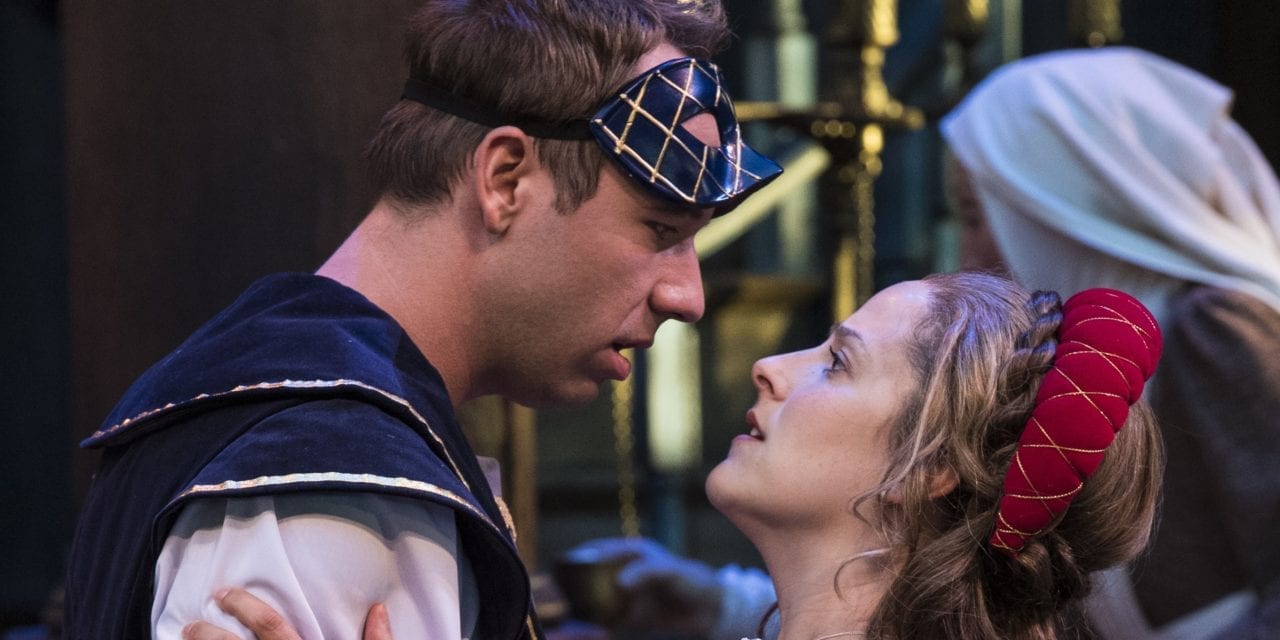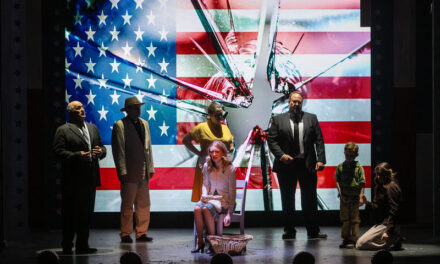CEDAR CITY — The Utah Shakespeare Festival has decided again to visit fair Verona and stage Romeo and Juliet this year in an insightful, well acted, and gratifying production that serves as a worthy companion to the Festivla’s current production of Shakespeare in Love.

Show closes September 9, 2017.
Rather than have the title characters careen inescapably towards doom (as in an ancient Greek tragedy), Director J. R. Sullivan makes each character an autonomous agent in the story. The result is a Romeo and Juliet that is a parade of “if only” scenarios. If only Mercutio had controlled his temper… If only Romeo and listened to the counsel of Friar Lawrence… If only Tybalt had accepted Romeo’s attempt to make amends… This creates a dozen ways in which the tragedy could have been prevented, and thus augmenting the pain and suffering of the play’s ending.
Sullivan also is effective at creating a rich context for the action of the play. The use of supernumeraries in the street scenes and at the ball created a Verona that had its own personality. Gossiping passers-by, party attendees minding their own business, and a small army of Capulet and Montague partisans provide a rich, satisfying backdrop for the principle characters. Sullivan also created contrasting family dynamics for the Montagues and the Capulets, furthering the sense of conflict between the two families. Juliet is clearly sheltered by her domineering mother and doting nurse, while Romeo’s father is more laissez-faire approach to parenting, thus explaining how his son could sneak into a party, fight in duels, etc. Sullivan showed these approaches by equating physical distance and emotional distance. Juliet’s mother and nurse sit on a bench close her to discuss the prospects of marriage, while Romeo’s father generally keeps his distance when on stage with his son.

Shane Kenyon as Romeo and Betsy Mugavero as Juliet. (Photo by Karl Hugh. Copyright Utah Shakespeare Festival 2017.)
Shane Kenyon and Betsy Mugavero star as Romeo and Juliet, respectively. The two create an amiable couple, with a relationship that grows organically from glances across the room until it reaches a crescendo of love and passion just before their separation. Kenyon’s Romeo is less mopey than most Romeos at the beginning of the play when he pines for Rosalind, avoiding a misstep that often makes the character seem petulant. Mugavero is splendid as Juliet, especially when showing the character’s angst as she conceives plausible scenarios for why Romeo would murder Tybalt. She makes Juliet an energetic character, instead of a passive waif. Mugavero and Kenyon also created an entrancing balcony scene that I wished I could have seen three or four times that night. The thrill and anxiety of forbidden love was a stunning reminder of why that scene is so famous.
Many of the supporting actors in Romeo and Juliet also created memorable performances. Leslie Brott squeezes every bit of comedy and charm she can out of the role of Juliet’s nurse. Yet, she could also display weighty sorrow as her character mourns the death of Tybalt. Jeb Burris‘s Mercutio is an ill-tempered hothead from his first scene, and I saw in him as the sort of friend that many parents would say is a bad influence on their children. Burris was an excellent alpha male to Romeo, and the two characters shared enough personality traits that Romeo’s actions in the wake of Mercutio’s death seemed completely logical. Melissa Graves provided a standout performance as Lady Capulet. Whether playing the protective mother hen to her daughter, or crying out for justice after Tybalt’s death, Graves ensured that all of her scenes reached their full potential of both entertainment and believability. Finally, Jonathan Gillard Daly‘s performance of Friar Lawrence showed the Franciscan as the voice of reason and a calm oasis in a otherwise turbulent Verona.

Shane Kenyon (left) as Romeo and Betsy Mugavero as Juliet. (Photo by Karl Hugh. Copyright Utah Shakespeare Festival 2017.)
And can we shed a tear for poor Paris, too? It is easy to forget that three people die in the tomb in the last scene of Romeo and Juliet. Paris, Juliet’s betrothed, is another victim of this tragedy, and his demise is even more sorrowful than the title characters’ because Paris was just carrying on with his life when Romeo murders him. Brandon Burk played Paris in this production. The script doesn’t develop the character much, but Burk has an appealing stage presence, and for the first time I asked myself about the character’s backstory. A savvy writer could create an interesting exploration of the character. (But perhaps my musings about the character says more about my past obtuseness than about this production.)
I also must sing the praises of Bill Black‘s costuming. Based on period costuming, the touch of modernity in the men’s shoes and pants was a pleasant surprise. Black also supported the storytelling by dressing the Montagues in blues and greens, the Capulets in shades of red, and the other characters in yellows and browns. This will help people less familiar with the story keep track of the differing factions in the play. And Juliet’s purple dress—a mix of red and blue, of course—is a nice subtle message about her place in Verona after her marriage to Romeo.
Like a young star-crossed lover, I fell madly in love with this production of Romeo and Juliet. The cast and creative staff at the Utah Shakespeare Festival have created a production that captured the beauty, sorrow, and anxiety of this classic story. This Romeo and Juliet will likely fulfill any hopes that audience members have for a satisfying Shakespeare experience.




